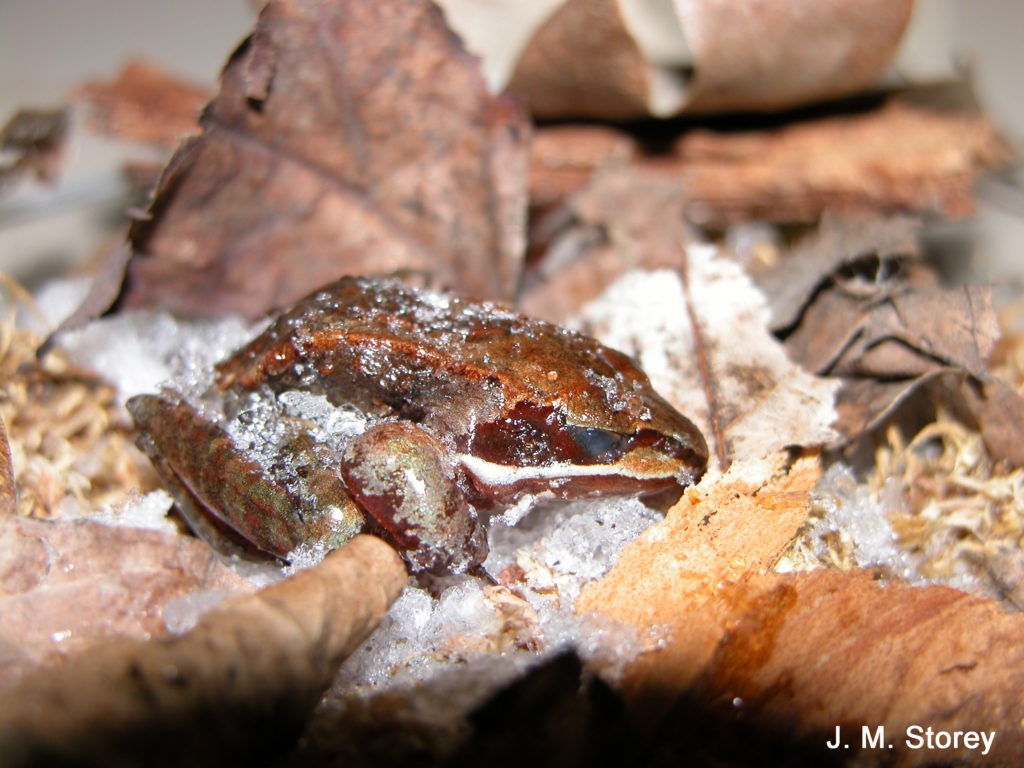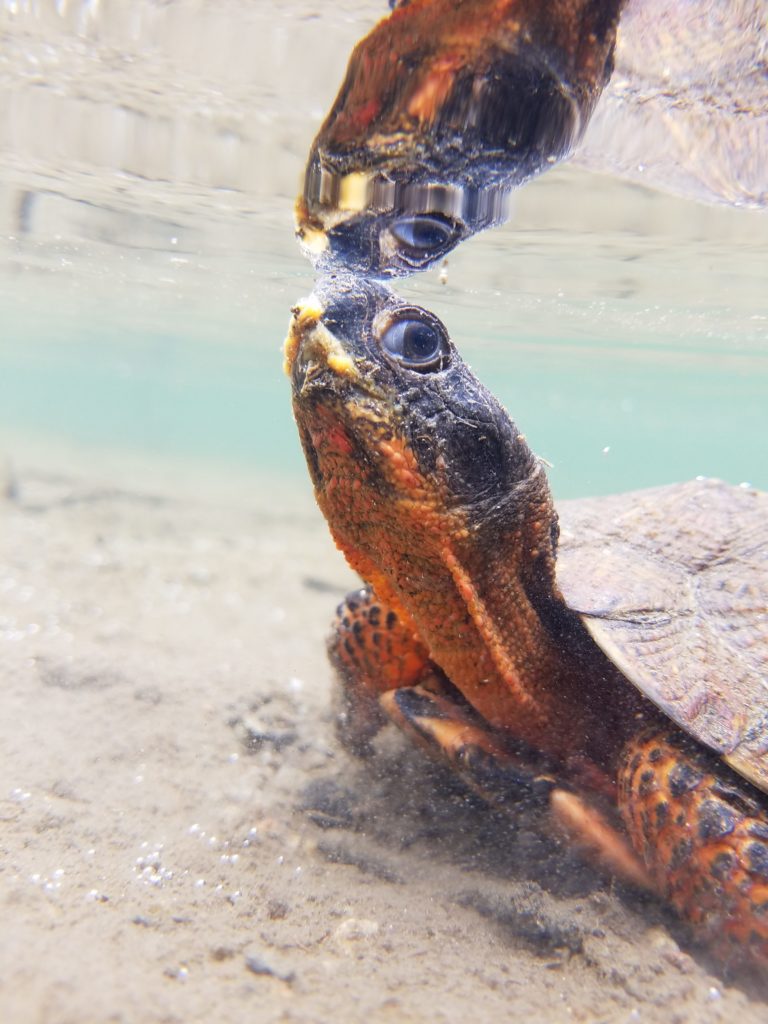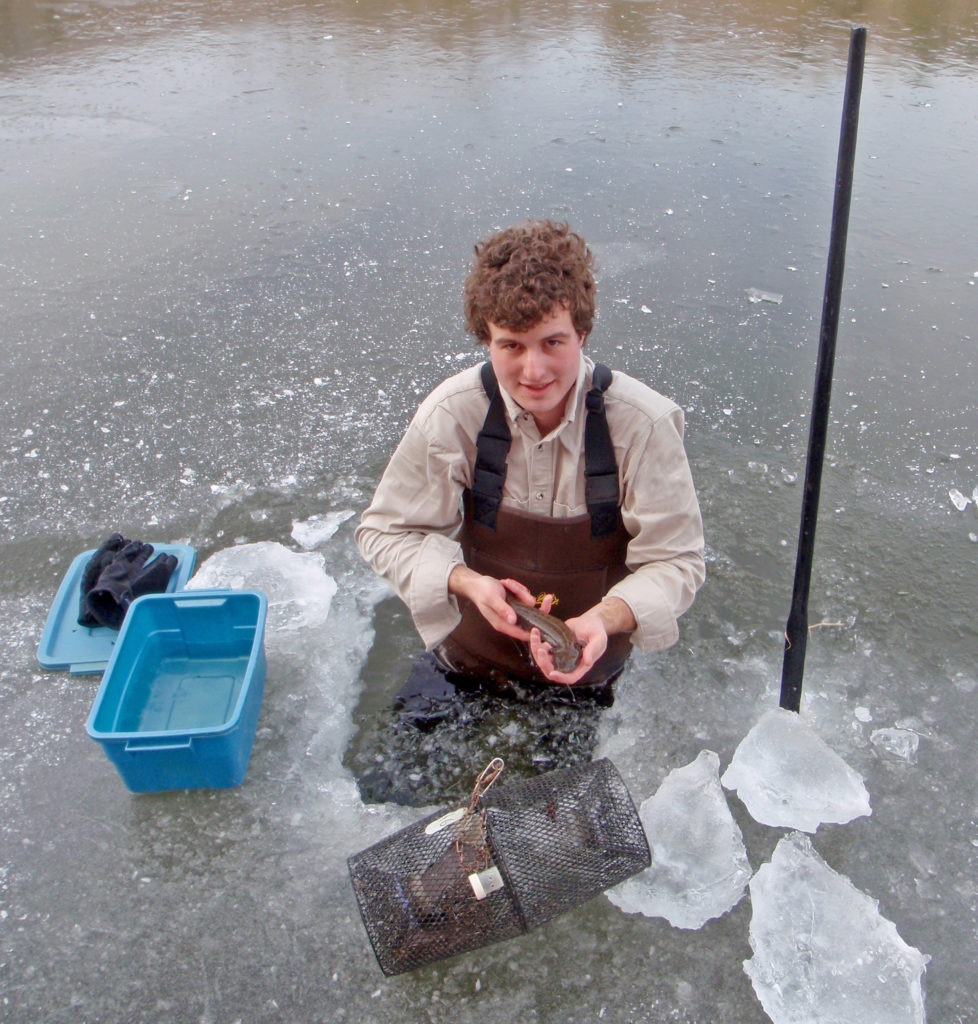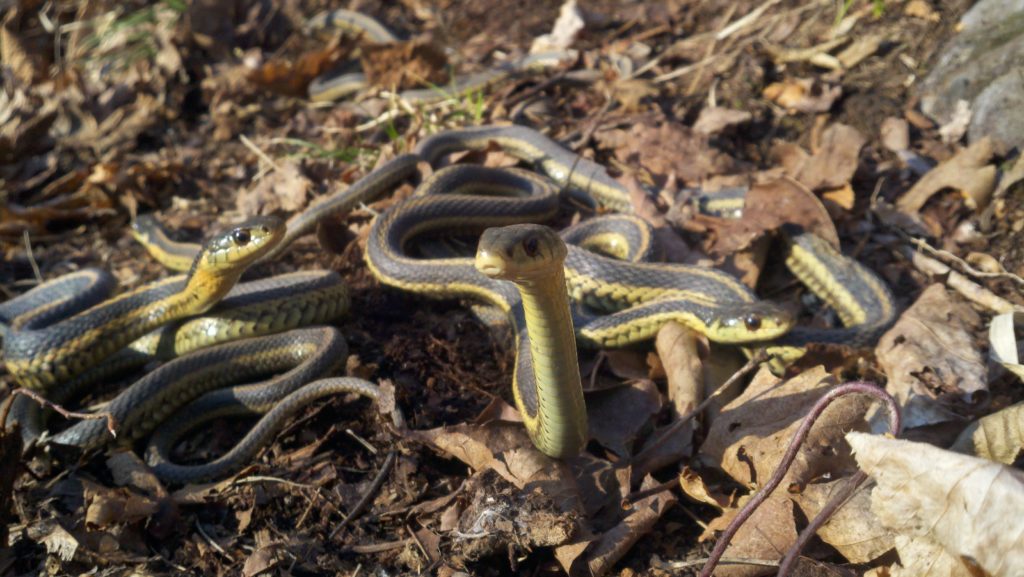Views:
Winter is not the best time to find reptiles and amphibians in the Northeast. Snow and ice might cover the landscape for months on end, so many of us who are fond of looking for these animals find other winter hobbies. But how do reptiles and amphibians survive under the ice and snow? Some are adapted to endure freezing temperatures, while others avoid ice all together by venturing underground or underwater. Here are a few examples of how New England reptiles and amphibians spend the winter.
Wood Frogs
Wood Frogs overwinter under the leaflitter in forests, and they are one of only a handful of amphibians capable of freezing nearly solid. By producing high concentrations of sugars between their cells, their tissues are protected from the damage caused when ice expands. They can typically survive freezing to about 23F (-5C). One study in Alaska found that Wood Frogs there could survive freezing to much lower temperatures. The high sugar concentrations in their bodies also allow them to drop a few degrees below the freezing temperature of water without actually freezing. Air temperatures may plummet to far below zero, but by sheltering under leaflitter and a layer of snow, Wood Frogs are also insulated from otherwise lethal temperatures. Winters with little or no snow coupled with bitter cold are bad news for Wood Frogs, as well as any other amphibians overwintering on land.
 Wood Frogs overwinter under leaf litter and can survive their bodies freezing almost entirely solid. Photo credit: J. M. Storey
Wood Frogs overwinter under leaf litter and can survive their bodies freezing almost entirely solid. Photo credit: J. M. Storey
Northern Leopard Frogs
Northern Leopard Frogs cannot survive being frozen like some other frogs and instead protect themselves by spending winters underwater. Their overwintering sites can have flowing water or not, but standing water that ices over sometimes suffers from oxygen depletion mid-winter, (anoxia). To avoid anoxia, the frogs need to find a spot that is at low risk of oxygen crashes. Sometimes they will just rest on the bottom of the water, but they also hide under cover. One fascinating observation during a radio telemetry study of Spiny Softshells in northern Lake Champlain was made when divers had to retrieve turtles to remove their radio transmitters. To their surprise, many of the turtles had Northern Leopard Frogs hibernating under their shells!
American Bullfrogs
Like Northern Leopard Frogs, American Bullfrogs overwinter underwater. While their overall wintering habits are similar to Leopard Frogs, there is one recent story of a local bullfrog that fascinated me. In September 2017, as frogs were settling into their overwintering habitat, a resident found a bullfrog in their springhouse. Concerned about the quality of his drinking water, he relocated the frog elsewhere on his property. The same frog, identified by its pattern and a scar, was seen in the springhouse again in October, so the owner took the frog for a 1.2 mile drive and released it in a pond. In November, the frog was back in his springhouse, along with another bullfrog, a Pickerel Frog, and a Green Frog. Springs make great overwintering habitat for amphibians because they almost never freeze, and oxygen levels are steady. This frog clearly knew what it was doing.
Painted Turtles
Painted Turtles have two uniquely different winter survival strategies depending on age. Adults, which live in lakes and ponds, generally just rest on the water’s substrate, but may burrow into the mud and leaf litter for additional protection. During that time, their metabolisms slow down, and they do not need to breathe surface air all winter. Instead, they extract oxygen through the skin lining the roof of their mouths and the inside of their cloacas. The non-technical term for this is “butt breathing”. Sometimes oxygen levels crash in their overwintering sites, which forces the turtles to get their oxygen from glycogen molecules stored in their own muscle tissue. The same process is used by humans during times of extreme physical exertion, and the resulting buildup of lactic acid is what causes that burning sensation in your muscles. After prolonged periods, that would kill most animals, but Painted Turtles buffer the acidity by extracting calcium from their shells. As seen in the video below, Painted Turtles also occasionally move from spot to spot, even under the ice.
Hatchling Painted Turtles, which hatch in the fall, remain on land in their nests through the winter and can actually freeze almost completely solid during that time. They can also drop below the freezing temperature of water without freezing through a process called supercooling. If they come into contact with an ice crystal while in a supercooled state they will freeze almost instantaneously. Painted Turtle hatchlings can survive being frozen as low as 25F (-4C) and can survive supercooling to as low as -4F (-20C). No other reptile can survive body temperatures that low.
Wood Turtles
Wood Turtles do not have the same tolerance for anoxia as Painted Turtles, nor can their hatchlings freeze. Like adult Painted Turtles, however, they overwinter underwater and extract the oxygen they need by absorbing it through their cloaca. Because they need high levels of oxygen in the water all winter, they do not typically hibernate in lakes or ponds where there is a high risk of anoxia. Instead, Wood Turtles overwinter in valley streams where oxygen levels remain high all winter. They might seek protection from floods and predators by sheltering behind rocks, in undercut banks, below beaver dams, or at the bottom of shallow pools. At northern latitudes, Wood Turtles might go 6 months without taking a breath of air.
Mole Salamanders
Mole Salamanders in the genus Ambystoma (a genus including Spotted and Tiger Salamanders) are named so due to their propensity to spend time underground in crevices, holes, and tunnels excavated by small mammals. Apart from the breeding season when these animals venture to the surface and migrate to wetlands, this is where the salamanders will spend most of their time, including the winter. Not a whole lot is known about what they do down there during the winter, but in their fossorial habitats they are at very little risk of freezing. If their bodies did freeze, however, they would not survive.
Mudpuppies
The winter is actually kind of a busy season for Mudpuppies. Fully aquatic, these salamanders never purposefully venture onto land and can be found in rivers, streams, and lakes. The early and late winter is when these animals breed, and they will remain fully active all winter. Numerous observations have been made of Mudpuppies moving from place to place and even foraging in mid-winter. In lab experiments, when given a choice, Mudpuppies prefer colder water with almost no exceptions. So long as they aren’t actually frozen, they are fine. Apart from research projects, most Mudpuppy observations in New England are made by people ice fishing.
Snakes
All New England snakes overwinter underground. Their preferred overwintering habitat varies by species, but the vast majority will be using crevices, rotten stumps, or cracks along building foundations to get below the frost line. Some, such as the occasional gartersnake, have been seen overwintering underwater, but that is not the norm. On some occasions, snakes venture into people’s houses for the winter, (usually basements or attics), where they either go unnoticed or unappreciated by their human cohabitants. In emergency situations, gartersnakes can survive being mostly frozen for short periods of time. The gartersnake’s mild frost tolerance is not enough for them to survive on the surface all winter in New England, however.
Stream Salamanders
Stream salamanders, like Two-lined, Dusky, and Spring Salamanders, do not need to travel far from their summer habitat to survive the winter. The fast-flowing water and spring-fed seeps they spend the summer in will not freeze solid in the winter and should maintain high levels of oxygen. These salamanders do not have lungs, instead getting all the oxygen they need by absorbing it from the water through their skin. Cold water holds more oxygen than warm water, so a stream salamander’s main concern in the winter is to just avoid being frozen. Many of the salamanders will find places to hide for the winter deeper in the river substrate, but these salamanders sometimes remain active all winter, even when air temperatures are far below freezing.
Every species has its own strategy for surviving the winter. Most do so by finding ways to avoid freezing temperatures, while others have adaptations to endure freezing conditions. Some have even figured out how to survive the freezing process itself. No matter how they do it, once the snow melts and the ice breaks up, these animals will spring forth from the hills and the mucky depths, and back into our lives once more.





